The following are recommendations for clothing and equipment to be used in recreating Benjamin Church’s Company. There is one very important point to be made in reading through this. We attempt to cover the period 1675-1707 with this unit. That encompasses some change in clothing, equipment and firearms. There are two important considerations to remember:
- Due to economic and technical realities (cost and hand production), clothing, equipment and firearms were often used over a long period of time. So an argument can be made for something older than the period being portrayed being used. What could not happen is for items that had not been invented yet to be used to portray a certain period. No time machines in use.
- Taking the first consideration in mind, it is possible to have three different sets of outfits – clothing, gear and weapon – for each f the wars portrayed, and some of us have been gradually working in that direction. But we also all started out at some point and we all understand the economic reality of reenacting. Therefore, as you will see, in starting out or if you only wish one outfit for Church’s then you should aim for the middle … 1690 … in this portrayal. This will be explained as you read on.
Weapons
Firearms
The following information comes mostly from Harold Peterson’s Arms and Armor in Colonial America, 1526-1783. Although there are problems with Peterson’s work, it still provides a handy reference.
What is appropriate for Church’s Company? First, be aware of the time frame. We are centered on a time period that encompasses roughly 1675-1707. We can set two basic rules:
- The weapon can’t be obviously from the period following 1707
- If an older weapon than 1675, it must be reasonable that it was still being used
Thus, with the Rule 1 we cannot allow Brown Besses of any kind. Even Queen Anne muskets would be stretching things, especially covering the earlier period.
Matchlocks fall under Rule 2. Peterson says “by the beginning of the fourth quarter of the 17th century it had practically disappeared as a military arm in America.” However, it had not disappeared entirely. For example, there is an existing matchlock that was used in Boston during the Glorious Revolution in 1689. But any reading of Church’s journal will show that matchlocks could not have been used by the men under his command. First, it is impossible to set up an ambush with a matchlock, and second, they were too active in their movements for a matchlock.
What they had were English locks, doglocks and true flintlocks. Peterson uses slightly different terms for these, calling what I call the English lock an “early doglock” and what I call the doglock a “later doglock.” To confuse matters even more, George Neumann in his Weapons of the American Revolution calls the English Lock an “English doglock” and provides no name for the later one. However, I think the distinction helps in identifying what we are talking about.
The English Lock had a lateral sear that pushed through the side of the lock plate and engaged the cock. It had a hook, or “dog” that served as a safety. This is the type of lock that Leonard Day features on his weapons. Scottish gunsmiths retained the lateral sear long after others had abandoned it, and therefore some of you may have seen this feature on the Scottish pistol reproductions. According to Peterson, English gunsmiths stopped making locks with lateral sears shortly after the middle of the 17th century.
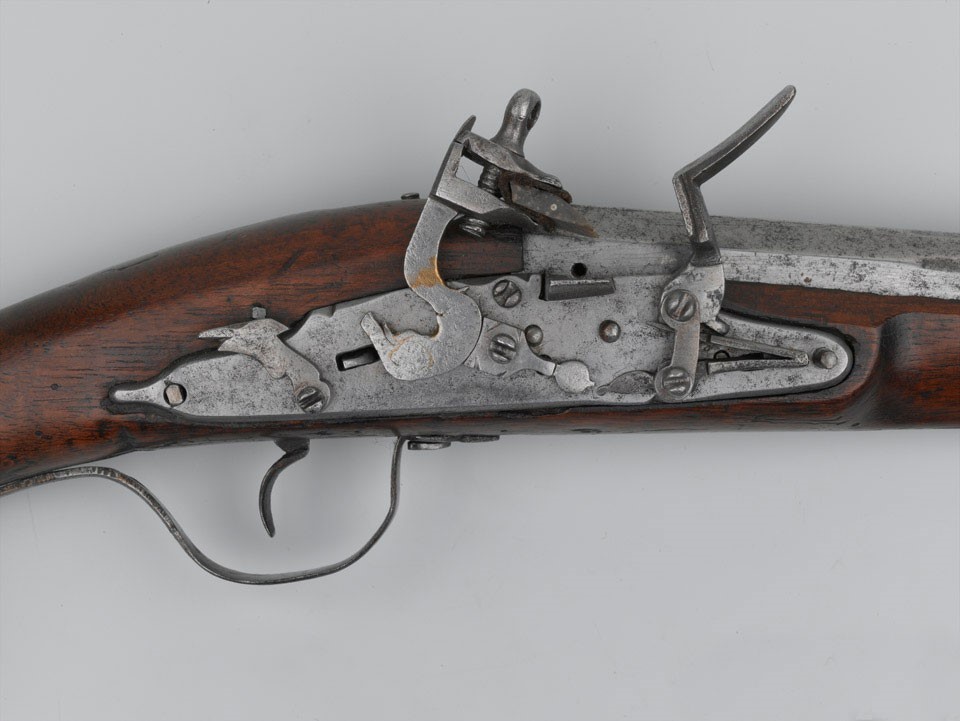
The Doglock had a vertical sear that was completely internal. It engaged slots in the tumbler. However, the dog safety hook was retained on the outside of the lock. Essentially, these locks look like a regular flintlock but with a dog catch. The English army used doglock muskets into the first years of the 18th century. Taking both styles together, Peterson says that “judging from the number of doglocks [English and Doglock] used in Colonial America that are still extant today, it would appear that that type of lock was more widely used than any other from about 1625-1675.”

The third style of lock was the True Flintlock. This was developed in France between 1610-1615. The true flintlock uses the vertical sear, with two slots in the tumbler, one for full cock and one for half cock. There is no need for an external safety catch. Peterson says that the true flintlock replaced the doglock in England between 1650-1675. He estimates that true flintlocks began to reach America by 1660. These early flintlocks had no bridle on the pan (the little arm that sticks out forward from the pan to help support the frizzen). That did not appear until the second quarter of the 18th century.
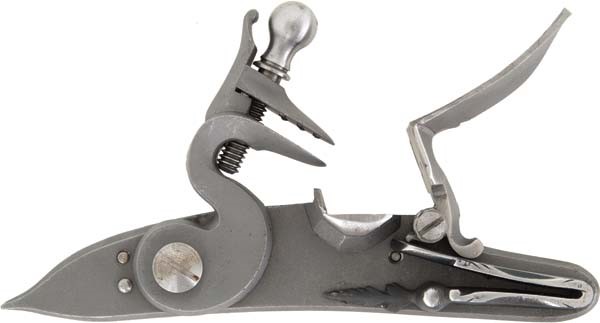
So where does that leave us?
Any kind of doglock would be acceptable and fit the period perfectly. This would be a lock with the external catch, or dog that hooks on to the cock, whether it has a lateral or vertical sear. However, the lock must have an internal half-cock, the dog cannot be the only half-cock. This is for event safety rules.
Any true flintlock that fits the time frame would also work. The lock should not have the pan bridle. I know this makes it harder to fit a flash guard, but the pan bridle is too late.
Another early feature of 17th century flintlocks are three lock bolts. If your lock has a lock bolt that screws into the tail of the lock, and it has no pan bridle, you are golden. Club butts tend to be early. A type C French trade gun dates back to 1690. For those planning to do both Harmon’s and Church’s, and even Eames’s Rangers, a later doglock, club butt fowler or early French trade gun would be fine for both.
Edged Weapons
Edged weapons follow the same guidelines as Harmon’s, essentially hatchet or sword, but a few things that might be different. Swords should not have the brass hilt, British or French issue look. Those cheap hangers so many have only date back to the early 1740’s. Stick to a hunting sword or cutlass with a more homemade hilt of sheet iron, wrought iron or antler. On the other hand, while we discouraged people from using plug bayonets in Harmon’s, a plug bayonet, especially if you have an early military arm (say a King William doglock musket), would fit the period just fine. There is some indication that plug bayonets were not common in the colonies, but the evidence in both directions is not conclusive. Avoid long rapiers; they would play hell getting in and out of a whaleboat. One thing, however, unfortunately (fortunate for a few that have them) we can’t have too many reproductions of Benjamin Church’s sword. Jeff Wardwell has made a couple of excellent reproductions, but there was only one Church sword originally. However, you can look for a sword similar in design, just be careful about an exact copy. We’re not absolutely forbidding this if you have your heart set on one, but just think about it.

Equipment
Ammunition
The standard method of carrying powder and ball through three-quarters of the 17th century was a bandoleer with wooden “bottles” hanging off for the main powder charge. Usually there was also a ball bag and some kind of holder for priming powder. There is evidence that these were in use as late as 1754. However, there are two issues with these: First, in portraying Church’s Company and his emphasis on ambush and stealth, the bottles bang against each other and make a great deal of racket. Second, the period we portray the paper cartridge was becoming more common. It was a time of transition. The manual we use for this period shows a transition from matchlock to cartridge and does call for the use of cartridges. [see article on bandoleers and cartridges]
So what to recommend?
- Belt Cartridge box: There were a couple of styles found on the Phips’s Ship sunk in 1690 and recently excavated. These boxes were leather wrapped open boxes, no solid blocks with holes drilled. Some had a solid open wood box inside, the others had thin slats of wood sewn to the leather. It appears some had cartridges with ball and other had cartridges with just powder, the ball probably simply carried in the pocket.
- Bill Payson, a member of the unit, makes an excellent reproduction of the Phip’s cartridge box, both variations. The style has been turning up in other sites, including the Whydah pirate ship.
- Hunting Pouch: Simple leather bag hung from shoulder. No known examples.
- Bandoleer and Bottles: Note if we do a tactical as Church’s Company you will not be allowed to use these so you will have to have one of the alternatives above. They make too much noise for woods warfare.

Powder Carriers: The drill we use does call for priming from a primer. These can be the typical 17th century powder flasks or a simple powder horn. Avoid the fancy, highly carved versions of the mid-18th century. But in using cartridges, priming can also come from the cartridge itself.
Leather Gear: This unit did not have issued equipment, so waist belts and other leather gear would be personal. The leather can be black or brown, and there are various forms of sword carriages. Many of the buckles seemed to be the double D variety.
Knapsacks: There is no government-issue “knapsack.” The two most common methods of carrying extra clothes and personal items would be a rucksack (simple linen bag with straps attached) or a snapsack.
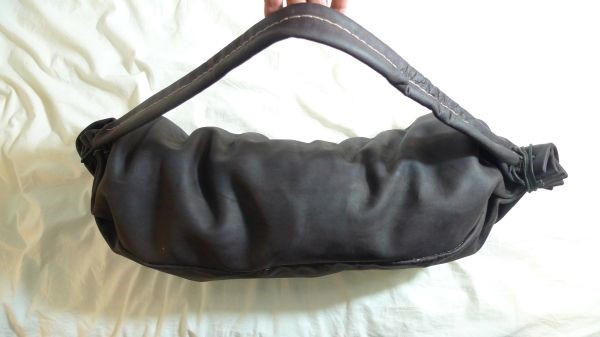

Blanket: We still try to show this unit on campaign. Most of us wear a blanket roll.
Canteens: The best canteens would be leather or ceramic costrel. A costrel has ears where the shoulder strap or waist tie (some were tied to the belt) is attached.
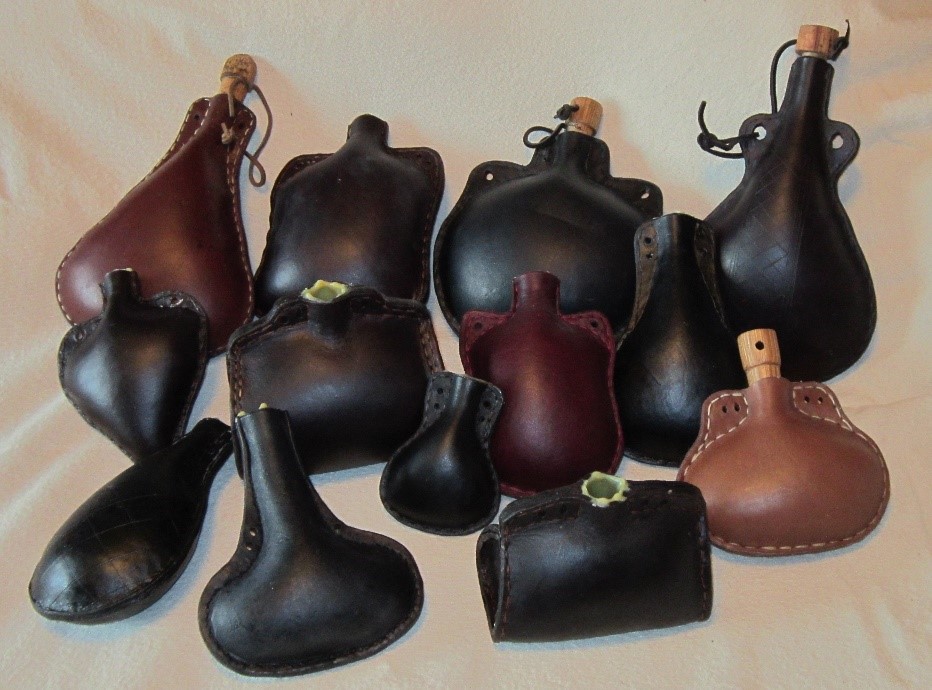
Cooking/Eating Gear: Look into 17th styles, tygs (redware cups with three handles), Bellarmine jugs, eating knives, 17th century spoons, etc. Forks were just coming in.

Clothing
Hats
Hat styles were going though a transition in Europe at the end of the 17th century. The broad brims were starting to be turned up to form a tricorn. It is doubtful that America was on the cutting edge of fashion, although travel between the colonies and England, especially for those connected to the sea, was fairly common. Most depictions of hats show wide brimmed hats with fairly low crowns. The prevalent style in the 17th century was to have a flat top to the crown, but, again, the turn of the century began to see a change to a rounded top. The brims were left flat or bent up in a variety of ways. Another style of hat was a knitted wool Monmouth cap.
Shirts
Benjamin Church made a statement about having his men take off their coats so potential rescuers could see they were English by their white shirts (1675). I am not sure how far to take this, but it would probably be a good idea to get a white or natural linen shirt. A long linen neckcloth was also used.
Coats
The King Philip’s War can have a mixture of earlier and slightly later styles. It was a period of transition from the doublet era to the coat era. What common people wore on a daily basis is hard to get a grasp on. As for coats:
- First, at the end of the 17th century had fairly straight lines, although fashion was beginning to introduce the full skirts of the 18th But for an everyday coat, the straighter lines and lesser skirts would make sense.
- Second, buttons and buttonholes tended to go all the way down the coat, in the front, in the back and even on the side pleats, although only the buttonholes on the front down to the waist are functional.
- Third, the coat is made so that it can be worn closed, unlike 18th century coats that tended to be left open to show the waistcoat.
- Fourth, buttons are generally shown as cloth covered, although that needs more research.
- Fifth, the sleeves were on the shorter side, not reaching the wrist, so that the sleeves of the waistcoat showed when worn.
- Sixth, the bottom lining of the sleeve was of the same material as the coat, so that the cuffs were formed by folding back the sleeve (exposing the lining, which is why it was the same material).
- Seventh, the pockets are lower on the coat than in the eighteenth century.
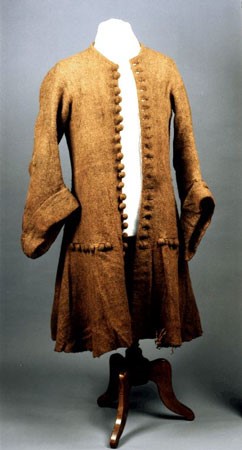
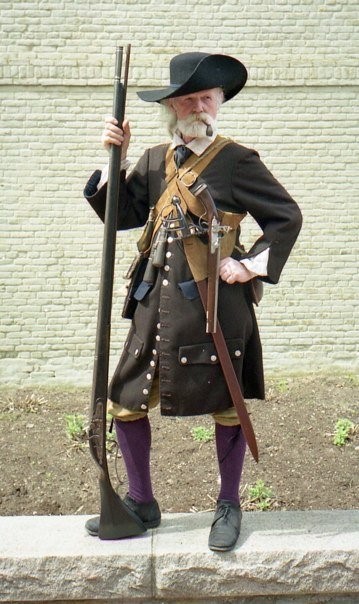
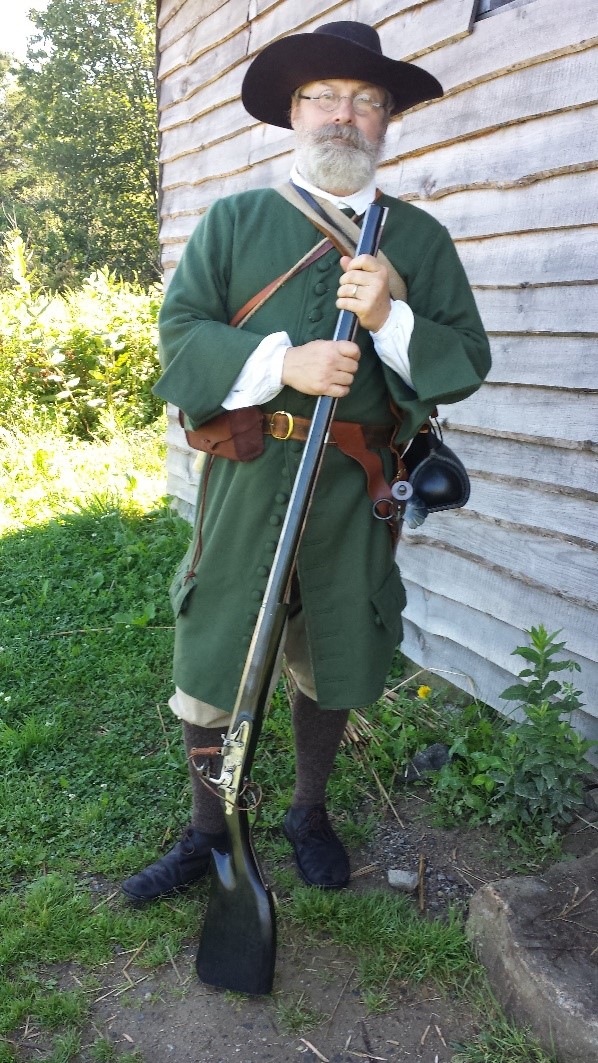
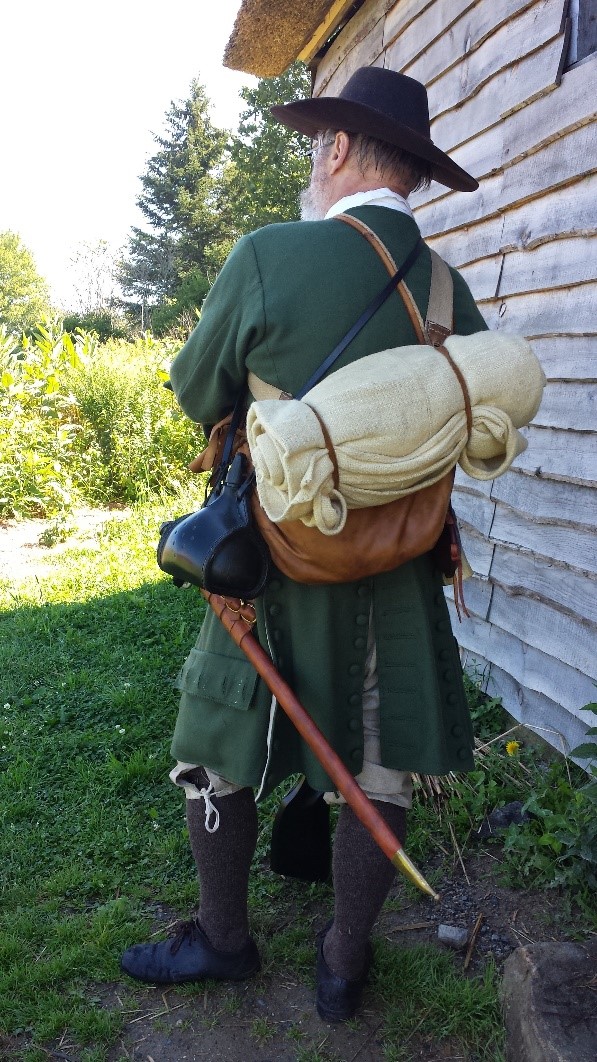
In addition to this basic style coat, there are two others that can be considered. Shorter, workman’s coats were common throughout the 17th and 18th century. The only difference might be the position of the pockets and the sleeve arrangements. There would be also be short, so-called “soldier’s coats” (winged shoulders, sometimes with the sleeve tied on), from the English Civil War period …1640s-1650s. I imagine common use still had them kicking around in King Philip’s War. The other jacket that may be considered, especially for King Philip’s War events, is the buff coat. This was a poor man’s armor, a leather jacket that offered some protection against arrows. According to Peterson, buff coats were on their way out but the last decades of the 17th century, but I’m sure they were still in evidence. They were distinguished by a number of features: 1. fitted to the waist then wider skirts that went to mid thigh; 2. some had sleeves, some did not, some had shoulder wings, some did not; 3. they were generally lined with linen; 4. they were tied down the front. The leather was buff (thick leather with the hair side shaved or roughed), although they used elk in Virginia. These are not the light-weight leather jerkins sold for Renaissance fairs.
Workman’s Jacket

Waistcoats
There seemed to be a definite aversion to showing the breeches, which is why they tended to be so shapeless. In the 18th century, as coats remained more open and waistcoats shortened, the look of the breeches changed rapidly. So waistcoats, when worn, were long and full in the front, often the waistcoat was only an inch or two shorter than the coat. The sleeves of the waistcoat could also appear below the shorter coat sleeve. So waistcoats were very full, and often (although not always) sleeved. They also had buttons that went all the way down in the front. However, they often had no tails in the back, or very short ones. This is speculation, but since the coats were often worn closed, in hotter weather the waistcoat was probably dispensed with (only later when coats were worn open did the waistcoat become more mandatory).
Breeches
As mentioned above, breeches were not meant to be seen, and tended to be baggy with not a lot of shape. Beyond the bagginess, there are a couple of generalizations: 1. they apparently often had slit pockets on the sides; 2. the bottoms were simply finished by folding up the hem to make a casing for a tie, and no buttons to close the slit; 3. The fly often had numerous small buttons, not the three or four seen in the 18th century.
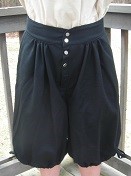
Shoes
The 17th century was a long time, a whole 100 years like most centuries, and styles for shoes changed considerably. In the first half of the century shoes tended to be low-cut with the sides cut open to reveal the socks (an idiotic fashion). By the end of the 17th century shoes had higher heels, square toes, and high tongues. The shoes brought up from the 1690 Phip’s Ship represent this style. The vast majority of reenactors in the 17th are doing the English Civil War period or earlier, and to date sutlers have been catering to that crowd, therefore the side-cut shoes are more readily available. Loyalist Arms has just brought out shoes resembling the late century shoes. Hi-Lo shoes or short boots were also around, especially for farmers.
- Loyalist Arms in Canada sells the square toe late 17th shoe with a buckle, so that is an option. You can get them either some or rough
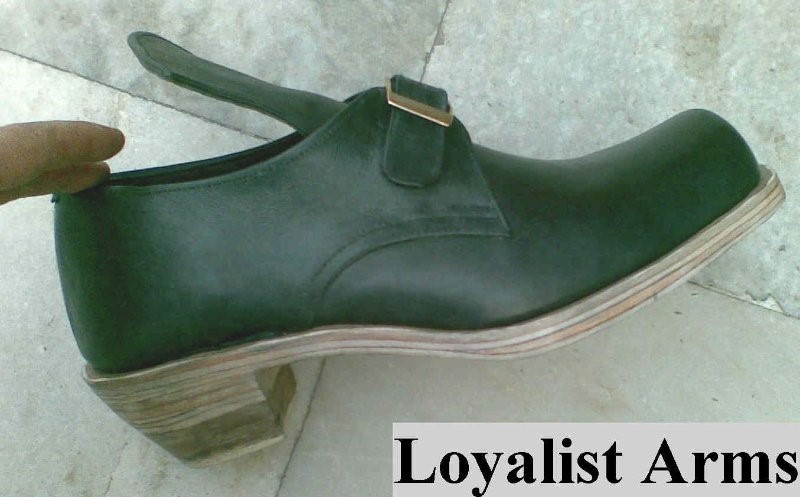
- Historical Footwear in England has a similar shaped shoe but with a lower heel
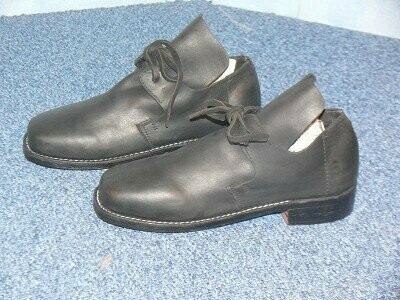
- However, most of us buy the low quarter, War of 1812 tie shoes from C&D Jarnagin. While purists might be upset as to how the sides look, to be honest, they represent a simple low quarter tie shoe that fits in all three time periods we do.
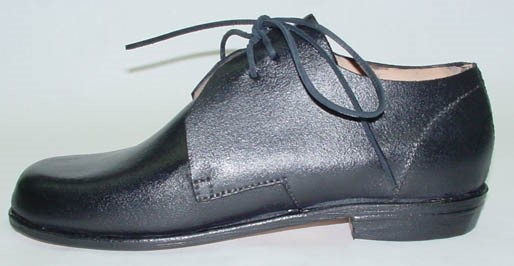
- If you are just planning on doing Church’s company then consider the Loyalist Arms or Historical Footwear shoes, if you are considering doing Harmon’s and/or Eames’s Rangers as well, go with the Jarnagin shoes.
Leggings
Here the evidence does not exist. We have not found reference to leggings or gaiters used by English in this period. Does that mean they didn’t wear them? No. We just can’t prove it one way or the other. Therefore, we don’t wear them.
Camping Gear
Please look under Harmon’s Company of Snowshoemen or Eames’s Rangers for descriptions of how we camp.